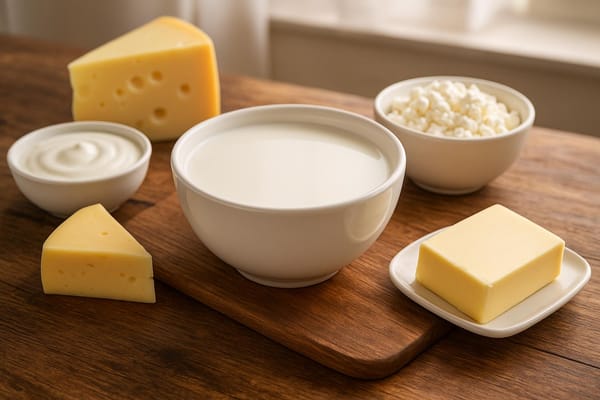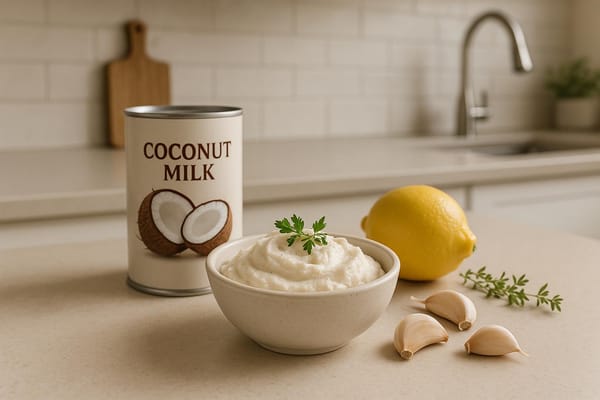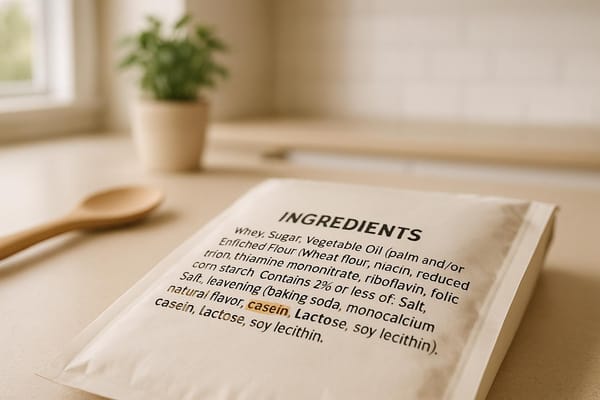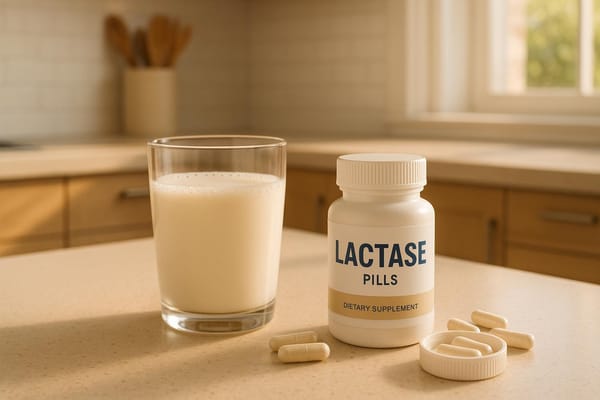Lactose Levels in Fermented Dairy Products
Learn how fermentation reduces lactose in dairy products like yogurt, kefir, and cheese, making them easier to digest for lactose-sensitive individuals.

Lactose in dairy can be hard to digest for many people, but fermentation helps reduce its levels, making products like yogurt, kefir, and cheese easier on the stomach. Here’s what you need to know:
- Yogurt: Fermentation breaks down lactose into lactic acid. Strained options like Greek yogurt have even less lactose.
- Kefir: Fermented with kefir grains, it contains lower lactose levels, especially after longer fermentation.
- Cheese: Aged cheeses like Cheddar and Parmesan have minimal lactose, while fresh cheeses retain more.
Quick Comparison
| Product Type | Fermentation Time | Lactose Content (per 100g) |
|---|---|---|
| Regular Yogurt | 4–8 hours | 3–4g |
| Greek Yogurt | 4–8 hours + straining | 2–3g |
| Kefir | 18–24 hours | 2–3g |
| Aged Cheddar | 3–24 months | <0.5g |
| Fresh Cheese | 1–3 days | 2–4g |
For those with lactose sensitivity, enzyme supplements like milktab can help make dairy digestion more manageable. Keep reading for tips on choosing the right products and understanding how fermentation works.
Lactose in Yogurt
Milk vs. Yogurt: Lactose Levels
Yogurt contains less lactose than milk because, during fermentation, lactose is broken down into lactic acid. This process makes yogurt easier to digest, especially for those with lactose sensitivity.
Factors That Influence Yogurt's Lactose Content
Several factors determine how much lactose remains in yogurt. These include the length of fermentation, the type of bacterial cultures used, the fermentation environment, and additional straining processes that remove whey. Each of these steps helps reduce the amount of lactose.
Lactose Levels in Different Yogurt Types
Different types of yogurt have varying amounts of lactose. For example, Greek-style yogurt, which undergoes extra straining, has lower lactose levels compared to traditional yogurt. Some brands also use extended fermentation methods to further reduce lactose content.
For those who are lactose sensitive, digestive enzyme supplements like milktab can make it easier to enjoy yogurt without discomfort.
Kefir Fermentation
Steps to Make Kefir
To make kefir, mix fresh milk with kefir grains and let it ferment at room temperature (68–72°F). Once fermentation is complete, strain out the grains to use them again. Some methods include a second fermentation step to enhance the flavor. This process naturally reduces the lactose content in the milk, as explained below.
How Kefir Reduces Lactose
During fermentation, active cultures in kefir grains break down lactose into simpler sugars and lactic acid. The extent of lactose reduction depends on factors like how long the milk ferments, the temperature, and the specific properties of the milk and grains used. Longer fermentation generally results in less residual lactose.
Kefir and Lactose Intolerance
Since fermentation partially breaks down lactose, kefir can be easier to digest for people with lactose intolerance. However, individual tolerance levels vary. For those with higher sensitivity, enzyme supplements like milktab can help with digestion. It's important to experiment with fermentation methods and monitor your own tolerance to find what works best.
Cultured Conversations Thought Leader Webinar
Cheese and Lactose Reduction
Just like kefir, cheese-making naturally reduces lactose, but it does so through a unique set of processes.
How Cheese-Making Reduces Lactose
Cheese-making lowers lactose levels in two main ways. First, milk is separated into curds and whey, with most of the lactose remaining in the whey. Second, during the aging process, bacteria continue to ferment the remaining lactose, which not only reduces it further but also develops the cheese’s flavor and texture. The longer the cheese ages, the more lactose is broken down, creating a richer and more complex product.
Lactose Levels in Different Cheeses
Lactose content varies depending on the type of cheese. Aged cheeses typically have very low lactose levels because the fermentation process has had more time to work. On the other hand, fresh cheeses contain more lactose since they undergo minimal processing and aging.
Best Choices for Low-Lactose Cheeses
If you’re looking for cheeses with reduced lactose, aged hard cheeses like Aged Cheddar, Parmigiano-Reggiano, Aged Gouda, and Swiss are excellent options. For fresh cheeses, which naturally have higher lactose levels, using products like milktab's triple-enzyme formulation can help with digestion. This way, you can enjoy a variety of cheeses while managing lactose sensitivity with ease.
Tips for Managing Lactose Intake
Fermented dairy products naturally contain less lactose due to the fermentation process, making them easier to digest. With the right product choices and digestive support, you can still enjoy dairy.
Choosing Low-Lactose Options
Here’s a breakdown of lactose levels in common fermented dairy products:
| Product Type | Fermentation Time | Lactose Content (per 100g) |
|---|---|---|
| Regular Yogurt | 4–8 hours | 3–4g |
| Greek Yogurt | 4–8 hours + straining | 2–3g |
| Kefir | 18–24 hours | 2–3g |
| Aged Cheddar | 3–24 months | <0.5g |
| Fresh Cheese | 1–3 days | 2–4g |
If you’re still struggling with digestion, a digestive enzyme supplement can make a big difference.
milktab: A Digestive Enzyme Solution

milktab offers a triple-enzyme blend designed to ease dairy digestion.
Tips for Enjoying Fermented Dairy
Fermentation reduces lactose, but these strategies can help you enjoy dairy even more comfortably:
- Take a digestive enzyme like milktab before eating dairy.
- Start with small portions to see how your body reacts.
- Spread out your dairy intake throughout the day.
- Combine dairy with other foods to slow down digestion.
"Milktabs work! During my European vacation, I enjoyed a variety of cheeses without discomfort."
Summary
Advantages of Fermented Dairy
Fermentation does more than just reduce lactose - it also introduces probiotics, making dairy easier to digest. This process can be particularly helpful for those with lactose sensitivity, as it not only improves digestion but also supports gut health and ensures a good intake of calcium.
How milktab Enhances Dairy Enjoyment
Fermented dairy products naturally have lower lactose levels, and when combined with milktab's triple-enzyme formula, they become even more accessible for people with lactose intolerance. Milktab provides 27,000 FCC lactase, 22,000 FCC protease, and 1,000 FCC lipase units, offering powerful support for breaking down lactose, proteins, and fats. This combination preserves the nutritional benefits of dairy while making it easier to digest.
From aged cheeses to tangy kefir and creamy yogurt, choosing the right products alongside enzyme support can make enjoying dairy both comfortable and satisfying.



